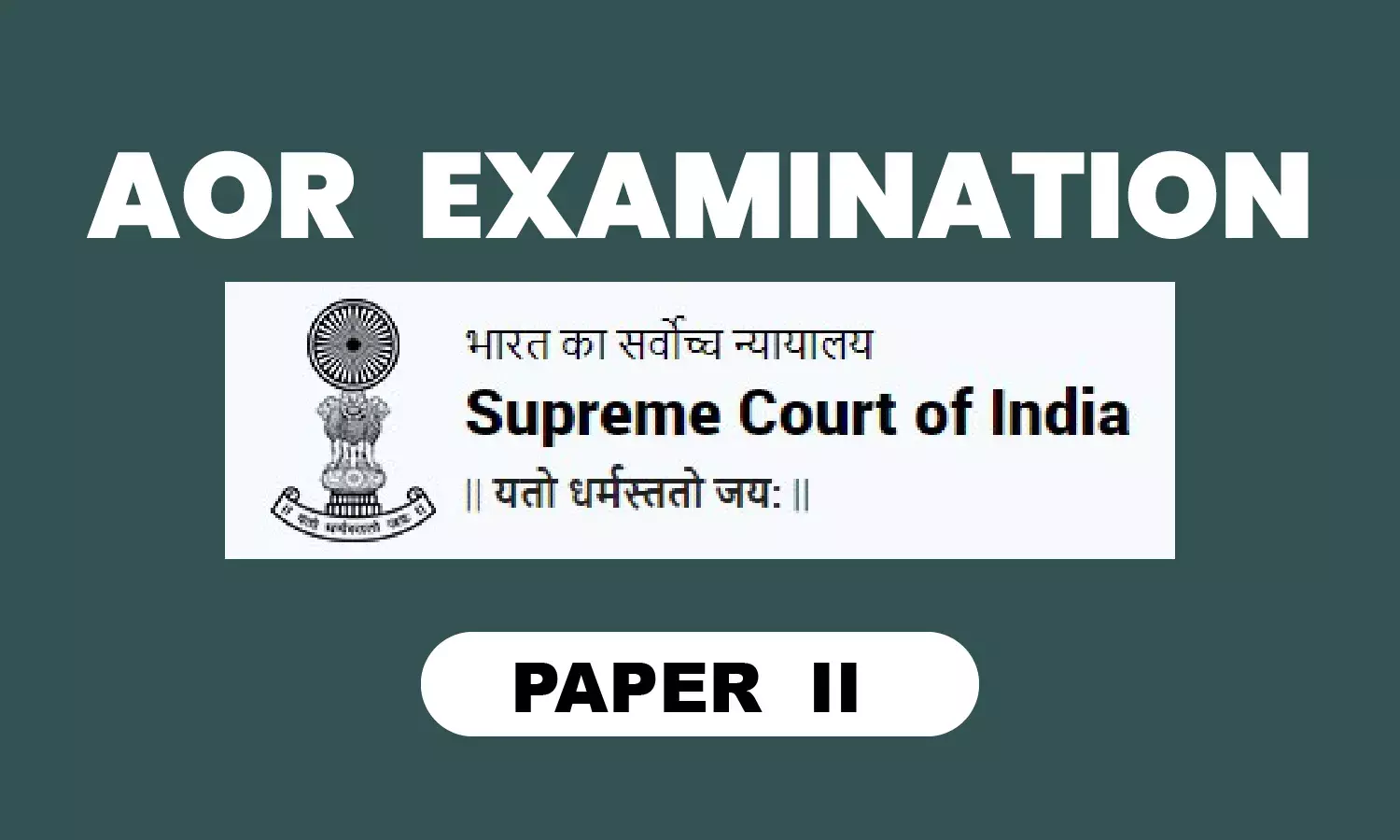Topper’s Answer Script, Sample Handwritten Notes And Guide Points On Paper-II ‘Drafting’ Before Attempting The Advocates-On-Record Examination, 2024
Last, but the beast! The length and complexity of Paper-II ‘Drafting’ with a pain-reliever of extra thirty (30) minutes in its surprising and pattern less style scares everyone, including the ones who appear as Toppers later. Mindful of the frightening tales, which always pass on in the corridors of the Hon’ble Supreme Court during the month before the summer vacations regarding the previous attempt every time, besides the unsolicited advice being given and general outlook of the paper being shared by the book-seller inside the court compound, I kept this paper to be studied at last, but eventually, could not study it all, until the day before the examination itself. Never such a course is advised, but it may have happened with many then, and may likely so to happen with many this time too, the basis may not always be the same. Although this paper is a test of the art of drafting, which many may possess in varying degrees of competency; however, putting it through pen and paper, no idea about the online mode which is happening for the very first time, within a restricted time in an examination hall, is altogether a different ballgame. The paper has a huge syllabus to take note of, including various affidavits, miscellaneous applications and what not, but the prior practical experience of drafting in practice of law would make up the necessary base in understanding the requirements of the paper; however, keeping the preparation largely focused upon execution during the examination. The following material consisting of my certified answer script, sample handwritten notes as well as guide points are most likely to aid in the preparation of the current examination.
Lectures by Ld. Senior Advocates organized by the Hon’ble Supreme Court of India.
The Lecture, as delivered by the learned senior advocates, for this attempt, especially by Sh. Jay Savla, Ld. Senior Advocate, (watch here) does provide the hints with nearly clear demarcation with respect to the important topics, but unlike the previous attempt wherein detailed description of topics was outlined, the following inputs as culled out must be taken strict note of without fail:
- The study be effected by dividing the jurisdictions of the Hon’ble Supreme Court of India into five (5) parts viz., Appellate, Original, Review/Curative, Counter Affidavit/Reply and Various Applications. The Supreme Court (Enlargement of Criminal Appellate Jurisdiction) Act, 1970 must also be studied along with the provisions of the Constitution of India in respect of appeals.
- The declarations required, especially in case of a Public Interest Litigation under Order XXXVIII Rule 12 of the Supreme Court Rules, 2013, and certificate required from an Advocate-on-Record regarding no new facts and no new documents in a Special Leave Petition, besides Certificate from a Ld. Senior Advocate in case of a Curative Petition, and annexures to accompany a petition, be also studied.
- It is important to note that there is no fixed format in case of a counter affidavit. Further, the miscellaneous applications seeking condonation of delay, adducing additional documents, suspension of sentence, permission to surrender, must always be accompanied with an affidavit.
- The drafts should be concise, not being lengthy and not having fancy words; more particularly, the synopsis should have bullet points including one or two questions of law.
- The question paper must be read meticulously. The paper may have one (1) long round question of forty (40) marks having everything a draft requires from start to end, and three (3) short questions valuing twenty (20) marks each. The requirement of the question must be studied very carefully, and it may be possible, that a particular question may require the candidates to write only question of laws, list of dates, etc. Further, the existence of a mandatory question, if there be any, should not be over-focused upon, but in any case, it shall be found interesting, and there shall be sufficient internal choice to cope up the paper in its entirety.
- No thoughts be built and action be taken upon the same believing that writing long answers, be it in ten (10) or twenty (20) pages, would fetch more marks, and therefore, no massive things be written. The candidates are expected to be methodical in terms of clearly mentioning the provision/order/rule under which the petition is being drawn, and should remain extra careful in drawing up a Special Leave Petition.
- The candidates must divide their one-hundred eighty (180) minutes with respect to the total one-hundred (100) marks, and accordingly, enter into time management, else, the issue of paper being found lengthy would invariably remain as such like always.
- The candidates must attempt all the questions, but should not repeat nor sidetrack, and should firmly remain focused by answering ‘to the point’.
- The candidates may earn more marks, if they write relevant case laws in support of their contentions in the draft.
Analysis of Past Years’ Question Papers of Advocates-on-Record Examination.
The analysis of past years’ question papers was not attempted to be done for this paper, primarily on account of it having an element of surprise and pattern less approach with too long a question paper to study, if so elected to be done at one’s end, besides there being a fundamental artistic component of knowledge and experience of drafting pertaining to practice at the Hon’ble Supreme Court of India remaining attached therewith otherwise. One should not attempt to analyse the past papers, but should use the same to practice reading, understanding and attempting the questions at one’s end, not only to correctly answer them, but to ensure that the same are done within the time and content requirements of the examination.
Perusal of Topper’s Answer Script in correlation with the Last Year Question Paper.
The perusal of the topper’s answer script when studied along with each question asked would bring the importance of following points of general consideration:
- Time-based content management i.e. the words’ limit up to which an answer be written commensurate with the value of marks ascribed to it.
- Appropriate Spacing provided.
- Limited Content.
- Margins being drawn on each page.
- Short points/paragraphs.
- Own language with element of legalese.
- Drafts as answers necessarily from next page.
- Headings and Titles in Capitals.
- Basic Clear Handwriting with Minimal Errors.
- One’s Own View as Note, whether for assumption or otherwise.
This paper, undoubtedly though, has remained to be the sole cause for many to fail in the examination, does not raise any question about the competence of such candidates, but largely, their strategy in attempting the said examination. In essence, neither it should become the cause for failure, nor the reason to abandon the said or the remaining papers in any manner. With the notion that ‘Failing to plan is planning to fail’, unlike in my case wherein I did not prepare for this paper fully, the others should not take it lightly, and be prepared mentally to face the rigours.
The above-shared exam pattern was devised for self-restraint in terms of putting content in the answer script, which was derived after carefully listening to the lecture delivered for the last attempt. One should not get flown by the thoughts of having a grasp on a particular subject and when a question is found relatable thereupon, write too much to remain with unreasonably less time for the remaining. It is a general suggestion that in this paper, if one knows how to write the answer for a question valuing more marks, then it should be attempted first, and the logic is very simple; the drafts normally require a similar amount of time and content, whether valued for twelve (12), fifteen (15) or twenty (20) marks, and therefore, with a little extra add-on, one can secure more marks by attempting the higher valued ones. The language should be respectful, polite and guarded as far as review and curative petitions are concerned, and should be brief and direct as to the error pointed out. It is important to avoid writing long sentences, and good, plain and correct English language would ensure the same magic. More or less, the required provisions, will be provided in the question paper, and although, substance is given more weightage than the format, but without a seemingly correct format, the substance won’t be able to show its substance as such. Since complicated facts may be there in a long question, one should first attempt to see the last of the question to determine as to what is being asked, and if found comfortable, then only should attempt to absorb the facts. In case of any confusion being found to be brewing up in mind, the question be strictly left then and there, and one should proceed ahead with the other. Invariably, the cause title is required, and one cannot be innovative in the prayer of a Special Leave Petition. Especially, in this paper, one should start the answer of every question from a fresh page. One should note, must already be known, that annexures are always marked in the List of Dates and not in the synopsis, and if the annexures are required to be marked, it shall specifically be mentioned in the question. Short forms, wherever required, are not a no as such, provided the full form of the word is used at the first available opportunity in the answer. The habit of not writing for years, which may be true for the majority who have opted for pen-paper mode, shall definitely find the paper taxing, but should not feel the battle to be lost, even if the paper does not go good. One should keep in mind that there are many candidates who have scored the minimum in drafting, but through good performance in other papers, they have been able to secure the aggregate, and after all, the story gets subsumed, when one gets registered as an Advocate-on-Record. The thoughts of appearing in the next paper i.e. Paper-III ‘Advocacy & Professional Ethics’, should keep the candidates relaxed and motivated to continue the battle heads-up.
With this, at the conclusion of the write-ups, there are certain points which the candidates must be apprised of, and it applies to all the papers in general. Since, purportedly, there is no honorarium/fee is payable to the examiners for evaluation of answer scripts, the handwriting should be so maintained so as to not further disincentivize the examiners. The fundamentals of parity require that a single ink, preferably blue in colour, be used, and no highlighters, pencil, marks, etc. be put to use, as it may otherwise be treated as adopting unfair means. In light of no model answer keys for the papers being prepared and no provision of revaluation being put in place, there is no mechanism available to re-assess the answer scripts, and therefore, focus should be to do one’s best, to the extent possible, as even one (1) mark can also make a difference. Important is the fact that the question papers are distributed ten (10 minutes) before the commencement of examination i.e., 11:00 a.m., and in case of Paper-II ‘Drafting’, another thirty (30) minutes be added, thereby giving the advantage of forty (40) minutes of reading time. For the new candidates, it is important to know that the candidates are allowed to bring in their bags to be kept inside the examination hall at a distance though, and are given the facility to keep their mobile phones with the invigilators, while they have the choice to keep all their belongings in their bags itself. No candidate is allowed to leave the examination hall thirty (30) minutes before the conclusion of the examination, except under exceptional cases and on health grounds. The candidates have to mark or sign their presence by signing on the attendance sheet paper wise or day wise in the examination hall, and after conclusion of the examination, the original roll numbers of the candidates are converted into fictitious roll numbers under the overall control/supervision of the Secretary, AOR Examination, and as such, this ensures anonymity so required in the evaluation of papers. The seating arrangement, as being done as a makeshift arrangement, may experience problems with a few chairs or tables, as was found during the last attempt, and therefore, the candidates must check the same as and when they first arrive inside the examination hall, and in such situation, do seek a change of the chair(s) and/or table(s), or their seat(s) altogether. Bringing one’s own watch is a life saver, as during last time, I myself had to get the wall clock corrected, which was showing a different time. Not much could be delved into the online mode of appearing this examination being introduced for the first time in this attempt, I wish the candidates all the very best.
Click here to read/download Author's sample handwritten note
Author is a practicing Advocate-on-Record at the Supreme Court of India, a practicing Advocate and a non-practicing Chartered Accountant. He secured 2nd rank in the Advocates-on-Record Examination in 2023.
[The opinions expressed in this article are those of the author. Verdictum does not assume any responsibility or liability for the contents of the article.]













